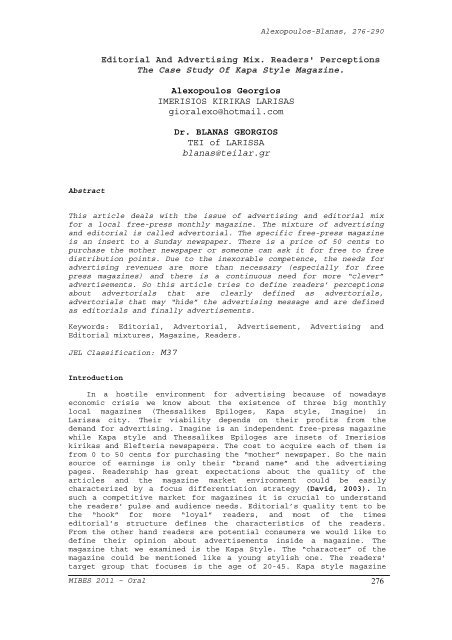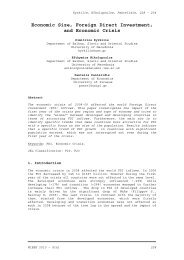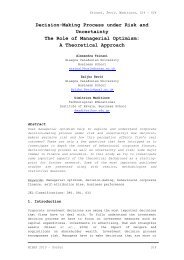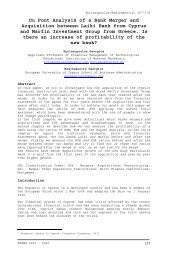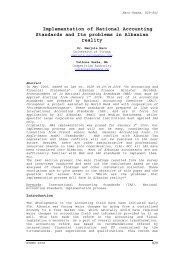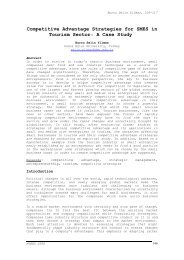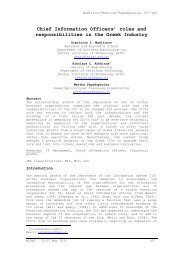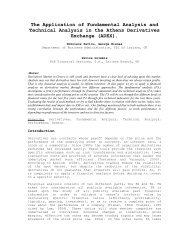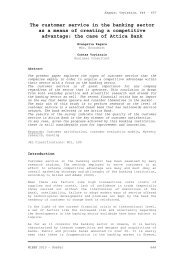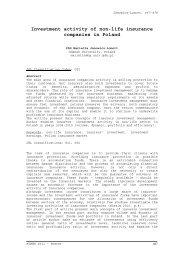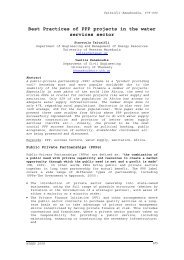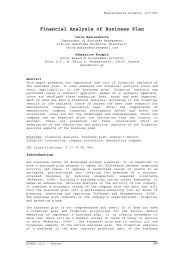Editorial And Advertising Mix. Readers' Perceptions The ... - mibes
Editorial And Advertising Mix. Readers' Perceptions The ... - mibes
Editorial And Advertising Mix. Readers' Perceptions The ... - mibes
You also want an ePaper? Increase the reach of your titles
YUMPU automatically turns print PDFs into web optimized ePapers that Google loves.
Alexopoulos-Blanas, 276-290<br />
<strong>Editorial</strong> <strong>And</strong> <strong>Advertising</strong> <strong>Mix</strong>. <strong>Readers'</strong> <strong>Perceptions</strong><br />
<strong>The</strong> Case Study Of Kapa Style Magazine.<br />
Alexopoulos Georgios<br />
IMERISIOS KIRIKAS LARISAS<br />
gioralexo@hotmail.com<br />
Dr. BLANAS GEORGIOS<br />
TEI of LARISSA<br />
blanas@teilar.gr<br />
Abstract<br />
This article deals with the issue of advertising an d editorial mix<br />
for a local free-press monthly magazine. <strong>The</strong> mixtur e of advertising<br />
and editorial is called advertorial. <strong>The</strong> specific f ree-press magazine<br />
is an insert to a Sunday newspaper. <strong>The</strong>re is a pric e of 50 cents to<br />
purchase the mother newspaper or someone can ask it for free to free<br />
distribution points. Due to the inexorable competen ce, the needs for<br />
advertising revenues are more than necessary (espec ially for free<br />
press magazines) and there is a continuous need for more “clever”<br />
advertisements. So this article tries to define rea ders’ perceptions<br />
about advertorials that are clearly defined as adve rtorials,<br />
advertorials that may “hide” the advertising messag e and are defined<br />
as editorials and finally advertisements.<br />
Keywords: <strong>Editorial</strong>, Advertorial, Advertisement, Ad vertising and<br />
<strong>Editorial</strong> mixtures, Magazine, Readers.<br />
JEL Classification: M37<br />
Introduction<br />
In a hostile environment for advertising becaus e of nowadays<br />
economic crisis we know about the existence of thre e big monthly<br />
local magazines (<strong>The</strong>ssalikes Epiloges, Kapa style, Imagine) in<br />
Larissa city. <strong>The</strong>ir viability depends on their prof its from the<br />
demand for advertising. Imagine is an independent f ree-press magazine<br />
while Kapa style and <strong>The</strong>ssalikes Epiloges are inset s of Imerisios<br />
kirikas and Elefteria newspapers. <strong>The</strong> cost to acqui re each of them is<br />
from 0 to 50 cents for purchasing the “mother” news paper. So the main<br />
source of earnings is only their “brand name” and t he advertising<br />
pages. Readership has great expectations about the quality of the<br />
articles and the magazine market environment could be easily<br />
characterized by a focus differentiation strategy (David, 2003). In<br />
such a competitive market for magazines it is cruci al to understand<br />
the readers’ pulse and audience needs. <strong>Editorial</strong>’s quality tent to be<br />
the “hook” for more “loyal” readers, and most of th e times<br />
editorial’s structure defines the characteristics o f the readers.<br />
From the other hand readers are potential consumers we would like to<br />
define their opinion about advertisements inside a magazine. <strong>The</strong><br />
magazine that we examined is the Kapa Style. <strong>The</strong> “c haracter” of the<br />
magazine could be mentioned like a young stylish on e. <strong>The</strong> readers’<br />
target group that focuses is the age of 20-45. Kapa style magazine<br />
MIBES 2011 – Oral 276
Alexopoulos-Blanas, 276-290<br />
“releases” 9000 copies every month except December, where the<br />
publication reaches the 12000 copies. <strong>The</strong> main quan tity of the copies<br />
are purchased as free inserts with the Sunday newsp aper (7000 copies)<br />
while the rest of them distributed to “hot points” as TEI of Larissa,<br />
Ster cinemas, central cafes, hotels e.g. <strong>The</strong> market ing department of<br />
the Kapa style magazine is the one that has to choo se what are the<br />
hot issues that the syntax department has to develo p, what are the<br />
possibilities to segment the market via syntax issu es and what else<br />
may develop a new market of advertised and of cours e which is the<br />
best way (time and icon) of promotion for every adv ertised customer<br />
via readers satisfaction. (Depken, Willson 2004). Kapa style publices<br />
10 editions in a year, one for every month except J anuary and August.<br />
<strong>The</strong> main issues of Kapa style are just five and the y are repeated<br />
after six months. Of course there are additional su bjects that are<br />
presented due to the need for more advertisements.<br />
Definition of Advertorials<br />
<strong>The</strong> mix of advertising and editorial is perceiv ed through columns<br />
as firm’s presentations, personal business profiles or special issues<br />
written in a “sneakily” commercial way. In some cas es advertising and<br />
editorial mix (advertorials) could be found on busi ness news columns.<br />
A well structured example of what is this advertisi ng and editorial<br />
mixture is given by Prounis (2004). In his article “<strong>The</strong> art of<br />
Advertorial” defines that the mixture of ads and ed itorial is named<br />
advertorial. So advertorials are ads designed for r eaders’ to be<br />
delivered as the experience of articles. This new f orm of advertising<br />
is effective and it promotes the existence and the creation of more<br />
powerful relations with magazine customers’. This i s a very important<br />
assumption because through readers’ reaction about this mix, we can<br />
understand the levels of consumption due to the fac t that every<br />
reader is a likely consumer. This base should make us able to perform<br />
a further and deeper investigation on readers’ pref erences. Readers’<br />
preferences and the existence of advertorials help kapa style’s<br />
marketing department to build annual advertising co ntracts with<br />
brands and also help magazine to define its own ann ual budget for<br />
self promotion.<br />
Literature Review<br />
<strong>Mix</strong>tures between advertising and editorial content<br />
Research on mixtures between advertising and ed itorial contents<br />
have shown that readers react differently to messag es that have the<br />
form of an advertisement than messages that like mo re to editorials.<br />
<strong>Editorial</strong> messages tent to receive more attention f rom readers and<br />
are easier to be remembered than “plan” advertiseme nts. So a<br />
successful advertisement is the one that has the fo rm of editorial.<br />
Leign, Zinkhan & Swaminathan (2006) in their research: investigated<br />
the recall for a print ad with “antecedent factors of ad<br />
characteristics and subjective reactions, and with how the<br />
antecedents relate to memory”, found that recall is more influence<br />
by cognitive and less by affective aspects, while r ecognition is more<br />
influenced by affective aspects. So we mention that the power of<br />
recall is based on the information that it gets and the recognition<br />
is based on more emotional factors. According to Dahlen & Edenius,<br />
(2007); Prounis, (2004); Kim et al., (2001) nowadays advertising is<br />
thought as editorial material for the magazines. Th e whole<br />
environment of this mixture seems to be blurring as (Angus, 2000; Kim<br />
et al., 2001) believe that the main problem for the editors is th e<br />
reader’s reaction to a misunderstanding of advertis ement which is<br />
supporting by a relevant article. Another research about advertising<br />
MIBES 2011 – Oral 277
Alexopoulos-Blanas, 276-290<br />
and editorial mixtures was held from Dahlen & Edenious (2007) argue<br />
that despite the fact that new advertising formats blur the edges of<br />
advertising and editorial environment, new forms of advertisements<br />
that placing ad message in an article make the mess age more difficult<br />
to be understood as advertisement and as a result, readers tent to<br />
evaluate those “articles” more favorably. Reijmersdal, Neijens, &<br />
Smit (2010) in their paper explain readers’ reaction to a sh ort of<br />
magazine that has not an every month theme but its content is unique<br />
and stable. <strong>The</strong>re is always a big dilemma about how someone can<br />
achieve the identical mix of commercials into edito rial content in a<br />
way to be well understood by readers and moreover t o stir their<br />
interest on ads.<br />
As it is observed from Jun, Purevu, Hyun & Gentry (2003) the<br />
influence of the editorial has a positive reaction to the related<br />
advertising. So they assume that in a specialty mag azine the power of<br />
the advertising recall is greater as the ad has a p rocessing and<br />
analytic character. <strong>The</strong>y also assume that the same hypothesis is<br />
strong enough in the case of how readers judge the ad of the specific<br />
advertised brand. So there is the need to form thre e hypothesis about<br />
readers’ perceptions about editorials and advertori als:<br />
H1 Does advertising and editorial mixtures, which a re perceived<br />
as editorial generate more attention from readers than those<br />
which are perceived as advertisement?<br />
H2 Does advertising and editorial mixtures, which a re perceived<br />
as editorial generate more appreciation from readers than<br />
those which are perceived as advertisement?<br />
H3 Does advertising and editorial mixtures, which a re perceived<br />
as editorial generate more acceptance from readers than those<br />
which are perceived as advertisement?<br />
Magazine Characteristics and advertisements<br />
A very important issue about advertising and ed itorial mixture<br />
has to do with the character of the editorial. Acco rding to Chang<br />
(2009) about narrative and argument advertising it is obs erved that<br />
readers appreciate more an argument article that is combined with an<br />
argument advertisement. Readers tent to adopt a mor e analytical way<br />
of thinking and react more positively to related ad s. Another article<br />
about magazines and advertising written by Rinallo & Basuroy (2009)<br />
supports the idea that strong advertised brands inf luence the<br />
coverage of a magazine, something that in case of K APA style is well<br />
combined with the strategic ambitions of the market ing department. So<br />
there is an interaction between advertising and edi torial and this is<br />
a way for a magazine to build its own form, style a nd brand. Nelson<br />
and Paek (2006) examined global advertising strategies based on<br />
global brands and local editions of magazines acros s seven countries<br />
(Brazil, China, France, India, South Korea, Thailan d, and USA) and<br />
identified a relationship between magazine’s editor ial and<br />
advertising taking care of the individual readers’ culture. As it is<br />
observed from Jun, Purevu, Hyun & Gentry (2003) the influence of the<br />
editorial has a positive reaction to the related ad vertising. In<br />
their study they observe the influence of editorial of a specialty<br />
magazine to the related ads. <strong>The</strong> results of this in vestigation are<br />
that analytical advertising supporting from analyti cal character of<br />
MIBES 2011 – Oral 278
Alexopoulos-Blanas, 276-290<br />
magazine and articles made readers more receptive t<br />
the advertisement.<br />
o the meaning of<br />
Researcher Consterdine (2000) in his report about magazine<br />
advertising effectiveness says that: “A successful and well<br />
understood advertisement should be “hooked” with th e appropriate<br />
theme (product category) so the readers not only to “shoot a brief<br />
glance” but to be real interested first about the s pecific article”.<br />
Method<br />
KAPA style magazine<br />
For this case study, KAPA style magazine is ch osen for its<br />
theme and ads shape that is combined in a way that allows as to<br />
measure the readers; reactions to the mixtures of e ditorial and<br />
advertorial. Its shape is defined by five different main theme issues<br />
(each per month) that are the “hooks” for advertise ments and support<br />
all relevant ads with appropriate articles.<br />
Participants<br />
So to give the population of the copies of maga zine, we have to<br />
mention that every month there are 9000 copies of K apa style. <strong>The</strong><br />
sample of participants that we used is 200 subscrib ers of the<br />
magazine. <strong>The</strong> audience was implemented from both wo men and men<br />
and the age of the participants will between 20 and 55 years<br />
old. <strong>The</strong> samples were systematically drawn from the subscribers’<br />
data bases. <strong>The</strong> participants will also be divined t o several groups<br />
according to their education age e.g An interesting research of<br />
Kaiser (2002) begins from the fact that “newspapers and magazines are<br />
faced by two different demand curves: the demand fo r copies of the<br />
print medium and the demand for advertising space. Due to the fact<br />
that Kapa style magazine has no accountable demand for copies,<br />
because its free press, we assume that the main rev enues come from<br />
advertising. So it is important to define who of th e readers are also<br />
advertising customers and who are not.<br />
Questionnaire<br />
<strong>The</strong> questionnaire is divined to four parts. <strong>The</strong> fir st part has<br />
some questions about the demographic characteristic s of the readers.<br />
<strong>The</strong> second part has some questions about the readin g habits of the<br />
participants. <strong>The</strong>n the third part is the main body of the<br />
questionnaire asking questions about advertorials, editorials and<br />
advertisements. <strong>The</strong> last part has some additional q uestions about<br />
magazines’ quality and so.<br />
Procedure<br />
Due to the fact that there is a need for the pa<br />
rticipants to have<br />
homogeneity and to know the specific mean of advert orial and<br />
editorial, there are definitions advertorial and ed itorial at the end<br />
of the questionnaire. <strong>The</strong> distribution of the quest ionnaires was held<br />
through the daily distribution of Kirikas newspaper , to its<br />
subscribers so to “earn” from participants that alr eady know the<br />
magazine.<br />
MIBES 2011 – Oral 279
Alexopoulos-Blanas, 276-290<br />
Measures and Manipulation check<br />
Readers’ attention<br />
Several studies were held about the acceptance and the evaluation<br />
of advertising mixtures from readers (Kim, Pasadeos & Barban 2001,<br />
Van Reijmersdal et al 2005) and we would like to investigate readers<br />
reactions to mixtures of KAPA style. Reijmersdal, Neijens, & Smit<br />
(2010) in their paper “Customer Magazines: Effects of Com merciality<br />
on Readers’ Reactions” explain the readers reaction to a short of<br />
magazine that has not an every month theme but its content is unique<br />
and stable. In order to measure attention for edito rial and<br />
advertorial themes instead for the media vehicle (K apa style),<br />
respondents were asked to answer how often they rea d editorial themes<br />
or advertorials. This is a case of measuring off-li ne attention<br />
(attention measured after exposure and not during e .g TV). So<br />
according to (Gunter 2000; Levy 1978) we have to ask participants how<br />
often they read those issues and to measure those f eatures in a five<br />
point scale (1=never, 5=always).<br />
Readers’ appreciation<br />
To measure the appreciation of readers to edito rial, advertorial<br />
and advertisements we used Smitt’s (1999) model for readers’<br />
appreciation to advertising. In this case we applie d a five point<br />
scale with (1=strongly disagree, 5=strongly agree). This model<br />
according to Smitt(1999) is based on three main beliefs:<br />
• Information: <strong>The</strong>me features (advertorials, advertis ements) give<br />
me useful information about special offers,” “<strong>The</strong>me features<br />
(advertorials, advertisements) provide me with usef ul<br />
information about specific products,” and “<strong>The</strong>me fe atures<br />
(advertorials, advertisements) give me new ideas ab out<br />
products.”<br />
• Amusement: “<strong>The</strong>me features (advertorials, advertise ments) are<br />
fun to read,”<br />
• Irritation: “<strong>The</strong>me features (advertorials, advertis ements) are<br />
obtrusive,” “<strong>The</strong>me features (advertorials, advertis ements) are<br />
too much alike,” and “<strong>The</strong>re are too many theme feat ures<br />
(advertorials, advertisements) in magazine X.”<br />
Readers’ Acceptance<br />
Trying to measure acceptance and misleading, ba sed on previous<br />
researches (Gupta et al. 2000) , we made two basic assumptions:<br />
• <strong>Mix</strong>tures of editorial and advertising brands (Adver torials) are<br />
acceptable.<br />
• <strong>Mix</strong>tures of editorial and advertising brands (Adver torials) are<br />
misleading.<br />
<strong>The</strong>se features will be measured on a five point sca<br />
disagree, 5=strongly agree).<br />
le (1=strongly<br />
MIBES 2011 – Oral 280
Alexopoulos-Blanas, 276-290<br />
Additional Hypothesis<br />
Additionally we must do two more hypotheses to fulf<br />
part of the questionnaire:<br />
ill the fourth<br />
• <strong>The</strong> first one is the assumption that theme features (simple<br />
issues) are more editorial than advertorial. This a ssumption<br />
will be answered by two questions:<br />
1. How much they believe that theme features and adver torials are<br />
forms of advertising? {Answered by five point scale , (1=strongly<br />
disagree, 5=strongly agree)}.<br />
2. Where do you believe that advertisers had paid to p lace an<br />
advertisement? {Answered by five point scale, (1=st rongly<br />
disagree, 5=strongly agree)}.<br />
• <strong>The</strong> second one has to do with the characteristics o f the<br />
magazine. So the hypothesis is the extent of author ity that<br />
each magazine has to readers’ eyes. Now the answer will be<br />
given from a five point scale (1=strongly disagree,<br />
5=strongly agree) check on the following three assu mptions<br />
that derived according to Aaker & Brown et al (1972) from<br />
past research on media quality and evaluation:<br />
1. I think X is a quality magazine<br />
2. <strong>The</strong> opinion of X’s editorial staff is important to me<br />
3. X is my favorite magazine<br />
Results<br />
Analysis of findings<br />
A total of 200 questionnaires were mailed to Ka pa style<br />
subscribers and 114 were filled, so there is a resp onse rate of 57%.<br />
<strong>The</strong> 61% of the subscribers are women and the averag e educational<br />
level is 14 years. In the research 20 of the subscr ibers are<br />
employees, 29 civil servants, 40 businessmen and bu sinesswomen, 4<br />
students and 21 with other occupation. <strong>The</strong> responde nts are 6 in the<br />
age between 20-25, 16 in the age of 26-30, 20 in th e age of 31-35, 17<br />
in the age of 36-40, 23 in the age of 41-45, 13 in the age of 46-50<br />
and 19 in the age of 51-55.<br />
About the readers’ reading habits a mean of 3,<br />
57 answers the<br />
amount of different newspapers that had been read p er week, while<br />
readers purchase 2,74 newspapers except Imerisios K irikas. Readers’<br />
also tent to read 2,88 magazines per month while th e buy 2,40.<br />
Readers’ perceptions about inserts, (measured with a 5 point scale<br />
climax) contacted a M3.9 for the frequency of readi ng, and a M3,46<br />
for the belief in their quality. Similarly, to the question “does the<br />
quality of newspaper defines its fame?”, readers an swered with a mean<br />
of 3,87. Readers also believe with a mean of 3,76 t hat the fame of<br />
the newspaper determines the quality of its inserts .<br />
<strong>The</strong> result of the investigation is that general ly theme features<br />
(M3.27, Std0.60) are perceived as advertising more than advertorials<br />
(M3.19, Std0.33). To be more specific we will imple ment a step by<br />
step analysis (Table 1) for every level of readers’ reactions<br />
(attention appreciation and acceptance). Readers’ a ttention for theme<br />
features (M 3, 73 STD 0, 96) is greater than for advertorials (M 3,<br />
MIBES 2011 – Oral 281
Alexopoulos-Blanas, 276-290<br />
32 STD 1, 17). In case of appreciation the results vary according to<br />
analysis for information, amusement and irritation. Readers’ tend to<br />
appreciate information more on theme features (M 3, 69 Std 0.92) and<br />
less on advertorials (M 3.59 Std 0.85) and advert isements (M 3.25<br />
Std 0.94). About amusement level, readers’ enjoy mo re theme features<br />
(M 3,49 Std 0,69) than advertorials (M 3,28 Std 0,65) and<br />
advertisements (M 2,65 Std 0,76). Finally readers seem to be less<br />
annoyed from theme features (M 2, 58 STD 0.96) and more from<br />
advertorials (M 2.65 Std 0.91) and advertisements ( M 3, 57 STD 1.00).<br />
Trying to measure acceptance we observe that theme features (M 4.03<br />
Std 0,80) are less accepted than advertorials (M 4,26 Std 0,72)<br />
while advertorials (M 2,71 Std 0,78) tend to be p erceived as more<br />
misleading than theme features (M 2,42 Std 0,79).<br />
Table 1<br />
<strong>The</strong>me features Advertorial Advertisements<br />
Attention M 3,73 Std 0,96 M 3,32 Std 1,17<br />
Information M 3,69 Std 0.92 M 3,59 Std 0,85 M 3,25 Std 0,94<br />
Amusement M 3,49 Std 0,69 M 3,28 Std 0,65 M 2,65 Std 0,76<br />
Irritation M 2,58 Std 0,96 M 2,65 Std 0,91 M 3,57 Std 1,00<br />
Acceptable M 4.03 Std 0,80 M 4.26 Std 0,72<br />
Misleading M 2,42 Std 0,79 M 2,71 Std 0,78<br />
Trying to identify the reliability of info rmation and<br />
irritation levels for theme features, advertorials and<br />
advertisements, (due to the fact that each one of t hese questions is<br />
a combination of two sub-questions) a Cronbach’s Al pha measure will<br />
be used. So according to the definition of Cronbach ’s Alpha ( Develles<br />
1991),<br />
{where K is the number of components (K-items or testlets),<br />
the variance of the observed total<br />
test scores, and<br />
the variance of component i for the current sample of cases.}<br />
It is observed that in case of information anal ysis, the<br />
Cronbachs’ Alpha are 0.79 for editorial 0.77 for ad vertorial and 0,46<br />
for advertisements, where the relevant values for i rritation are 0.71<br />
for editorial, 0.69 for advertorial and 0.73 for ad vertisements. In<br />
case of information level the Cronbachs’ Alpha for advertisements do<br />
no build a reliable scale 0.46 so the mean analysis will be contacted<br />
(M=3.25 Std 0.94).<br />
To test the research question, we conducted Gen eral Linear Model<br />
(GLM) repeated measure analysis and we implemented the format: theme<br />
features versus advertorial. In this case we assume attention,<br />
appreciation (information, irritation, misleading) and acceptance<br />
(acceptable, misleading) as depended variables and provides<br />
regression analysis and analysis of variance for ea ch factor.<br />
MIBES 2011 – Oral 282
Alexopoulos-Blanas, 276-290<br />
Attention<br />
Readers’ pay more attention reading editorial theme s than<br />
advertorials F(1,227)=8.36 p
Alexopoulos-Blanas, 276-290<br />
advertorials may be more misleading than editorials . Probably the<br />
greater acceptation to the advertorials has to do w ith their<br />
structure and the placement (Prounis 2004) inside the magazine.<br />
(Placement before the first issue and before the la st one) <strong>The</strong> third<br />
outcome has to do with magazines characteristics. I n each case<br />
readers seem to believe in the quality of Kapa styl e magazine (Appel<br />
2000), its theme features and structure. This outcome is given by a<br />
grant mean of M=4.03 in a five point scale. In this part questions<br />
that had to do with the appreciation to structure a nd theme issues<br />
that are relevant with the quality of the print med ia. <strong>The</strong> fourth<br />
and last outcome of this investigation is focused o n readers’ groups<br />
as potential product customers. In every case reade rs probably<br />
believe with a mean of M=3.78 that placement of bra nd inside theme<br />
features has some cost for the advertisers. Another great aspect that<br />
is found is readers’ segmentation per age, sex, occ upation and<br />
educational level. Each one of the previous reader- factors defines<br />
some of the audience characteristics. A basic assum ption of this<br />
investigation is the sample’s structure that is bas ed on subscribers’<br />
data bases. <strong>The</strong> subscribers sample was chosen due t o the assumption<br />
of its homogeneity. Its own homogeneity is proved b y the common norm<br />
and direction of readers’ perceptions in every case . Although the<br />
common reactions, readers per group tent to react m ore or less close<br />
to the middle of the five point scale. For those re asons, an extended<br />
analysis to the variances of every group was made.<br />
Sex level analysis<br />
Women’s reactions generate more attention and ap<br />
men’s ones, while men have higher levels of accepta<br />
magazine.<br />
preciation than<br />
nce for the<br />
Education level analysis<br />
High school graduates give more attention to the me features and<br />
advertorials than every other educational group. It is observed that<br />
as we move to higher educational level, attention o f the group has<br />
lower prices. About theme information and amusement , lyceum graduates<br />
have the first place followed by high school gradua tes, university<br />
degree graduates and final Master or PhD owners. I n case of<br />
advertorial information as the educational level gr ows up, the degree<br />
of information falls. Lyceum graduates have the fir st place on<br />
advertorial amusement with second the university gr aduates and then<br />
the high school graduates and Master or PhD owners. <strong>The</strong> first place<br />
for advertisements information is held by Lyceum gr aduates and the<br />
second from high school graduates. University degre e and Master or<br />
PhD owners seems not to be so interested from the a dvertisements’<br />
information. Advertisements seem to amuse more univ ersity and lyceum<br />
graduates and less high school graduates and higher educational level<br />
readers. <strong>The</strong> amusement for advertorials and adverti sements is higher<br />
to middle and high level of education and gets lowe r to basic and<br />
higher educational level. <strong>The</strong> irritation level for editorial,<br />
advertorial and advertisements falls as the educati onal level grows.<br />
<strong>The</strong> acceptance for editorial is higher on lyceum an d Master or PhD<br />
level and lower on university and high school level . <strong>The</strong> advertorial<br />
acceptance level is higher in higher level of educa tion and falls as<br />
educational level declines. Higher or middle educat ional level<br />
respondents tent to feel more misleading for editor ials than high or<br />
low educational level readers. <strong>The</strong> misleading degre e for advertorials<br />
is higher for higher level of education and decline s to lower levels.<br />
MIBES 2011 – Oral 284
Alexopoulos-Blanas, 276-290<br />
So the author assumes that he higher the educationa<br />
readers the lower their interest for magazines.<br />
l level of the<br />
Occupation level analysis<br />
Readers which occupation has to do with business tent to have<br />
greater degree in theme attention, information, amu sement, irritation<br />
and misleading. For this group there is a similar b ehavior for<br />
advertorial information, amusement and irritation. More acceptable<br />
for all levels of investigation are students and th en employees. Of<br />
course the number of students is only 3% of the sam ple and it is so<br />
small to be considered for further analysis. It is difficult to make<br />
an assumption about readers income based on their o ccupation (e.g.<br />
other occupation) but as it is observed readers who se occupation is<br />
business tent to have generally higher levels of ad vertising and<br />
editorial mix that are perceived as editorial than those perceived as<br />
advertorial.<br />
Age level analysis<br />
Another part that it is simply mentioned is the age of the<br />
readers. 20-25 aged readers pay significant less at tention to theme<br />
features and advertorials, while 41-55 aged readers pay more<br />
attention. From the age of 46 and up readers seem t o assume more<br />
information from editorials and advertorials. <strong>The</strong> a ge 41 and up has<br />
greater degrees of amusement for editorial features , advertorials and<br />
advertisements. Similar are the findings in case of irritation. Older<br />
people seem to irritate more in every case. <strong>The</strong> mos t acceptable<br />
readers are those on groups 31-35 and 41-45. Younge r readers (20-25)<br />
seem to have a greater degree of misleading level f or each case.<br />
Probably what is defined is that magazine and more general print<br />
media are not so favorable to young people who may prefer other ways<br />
to inform and get information about products.<br />
ders.<br />
wspapers’ files<br />
arative analysis<br />
essary. Customer-<br />
and in all levels<br />
readers probably<br />
rtised customers)<br />
they attend and<br />
while they seem to<br />
of advertising<br />
y also believe<br />
torials could be<br />
group, in every<br />
ive and amusing<br />
isements also seem<br />
ls.<br />
Readers who are magazine’s customers and simple rea<br />
Due to the fact that some readers’ according to ne<br />
are also advertised customers of Kapa style, a comp<br />
between customer-readers and simple readers was nec<br />
readers belong to the occupation group of business<br />
of analysis seem to have higher means. So customerdue<br />
to their own double attribute (readers and adve<br />
are more like to put themselves in a position that<br />
appreciate more theme feature shaped advertorials,<br />
accept more advertorials probably because such kind<br />
due to their own experience was more efficient. <strong>The</strong><br />
with a greater mean than simple readers, that adver<br />
more misleading than theme features. Finally every<br />
case believes that advertisements are less informat<br />
than theme features and advertorials. Single advert<br />
to irritate more than theme features and advertoria<br />
Recommendations for further research<br />
This research investigated readers’ perceptions about editorial<br />
and advertising mix. Finally it is realized that fu rther<br />
investigation to new forms of advertising can be co nducted. Another<br />
great aspect that could be the base for research is the structure and<br />
the shape of advertising mix according to emotional , visual and<br />
MIBES 2011 – Oral 285
Alexopoulos-Blanas, 276-290<br />
placement (inside the media) parameters. Overall th ere are many other<br />
paths that combine advertising mixtures with reader s to be<br />
investigated. Some further research could be done a ccording to<br />
acceptance, appreciation, attention and the degree of recall combined<br />
with the degree of advertisements recall. Generally there could be<br />
further research to any kind of advertising mixture not only in print<br />
media, but also on movies, video-clips, athletic ev ents e.g. Also an<br />
analysis of this paper gives practical information about magazine’s<br />
improvement and advertising improvement. <strong>The</strong> combin ation of these two<br />
aspects is strong enough to investigate how to buil d a growth formula<br />
for magazine and create more revenues, targeting on specific readers<br />
and expand the publication copies to readers with s imilar “golden”<br />
characteristics.<br />
REFERENCES<br />
1.Aaker.D.A , Brown.P.K, (1972) “Evaluating vehicle source.” Journal<br />
of advertising research Vol. 12, No. 4, pp10-16<br />
2.Angus. S, (2000) “Advertorials: an unholy marriag e”, Editor &<br />
Publisher, Vol. 133, July, p. 46<br />
3.Appel.V, (2002) “<strong>Editorial</strong> Environment and Advert ising<br />
Effectiveness” Journal of <strong>Advertising</strong> Research. Vol . 40, No. 6<br />
4.Consterdine.G, (2000) “Pre-testing and monitoring the effectiveness<br />
of magazine advertising” Research report Vol 61 May<br />
5.Dahlen, M, Edenius. M, (2007). “When is advertisi ng advertising?<br />
Comparing responses to non-traditional and traditio nal advertising<br />
media.” Journal of Current Issues and Research in A dvertising<br />
Vol29 No1 pp33 – 42<br />
6.David.F, (2003) “Strategic Management Concepts an d Cases” 9 th<br />
edition. Prentice Hall, London.<br />
7.Davis.J, (2005) “Maxim magazine and the managemen t of contempt” <strong>The</strong><br />
Journal of Popular Culture, Vol. 38, No. 6 pp1011-1 021<br />
8.Decrop.A, (2007) “<strong>The</strong> influence of message format on the<br />
effectiveness of print advertisements for tourism d estinations.”<br />
International Journal of <strong>Advertising</strong>, Vol 26 No 4, pp. 505–525<br />
9.Depken.C, Willson.D, (2004) “Is <strong>Advertising</strong> a Goo d or a Bad?<br />
Evidence from U.S. Magazine Subscriptions.” <strong>The</strong> jou rnal of<br />
Business, 2004, Vol. 77, No S2<br />
10.Depken.C, (2004) ”Audience characteristics and t he price of<br />
advertising in circulation industry: Evidence from U.S magazines”<br />
Information Economics and policy Vol. 116, No 2, pp 179-196<br />
11.Gunter.B, (2000) “Media Research Methods. Sage publications Ltd.<br />
London<br />
12.Gupta, P.B, Balasubramanian.S.K, Klassen.M.L, (2 000) “Viewer’s<br />
evaluations of product placements in movies: public policy issues<br />
and managerial implications”, Journal of Current Is sues and<br />
Research in <strong>Advertising</strong>, Vol. 22, pp. 41-52<br />
13.Jun.S, Putrevu.S, Hyun.Y.J & Getry.J.W, (2003) “ <strong>The</strong> influence of<br />
editorial content on consumer response to advertise ments in a<br />
specialty magazine” Journal of current issues and r esearch in<br />
advertising. Vol 25 no2 pp1-11<br />
14.Kaiser.U, (2002) “Optimal cover prices and the e ffects of website<br />
provision on advertising and magazine demand “Centr e for European<br />
Economic Research. Discussion Paper No. 02-54 Augus t 1 st<br />
15.Kaiser.U, Wright.J, (2006) “Price structure in t wo-side markets:<br />
Evidence from the magazine industry.” International journal of<br />
industrial organizations Vol. 24, No.1 pp1-28<br />
16.Kim.B.H, Pasadeos.Y, & Barban.A, (2001), “On the deceptive<br />
effectiveness of labeled and unlabeled advertorial formats”, Mass<br />
Communication & Society, Vol. 4 No. 3, pp. 265-81.<br />
MIBES 2011 – Oral 286
Alexopoulos-Blanas, 276-290<br />
17.Leigh.J.H, Zinkhan.G.M, Swaminathan.V, (2006) “D imensional<br />
relationships of recall and recognition measures wi th selected<br />
cognitive and affective aspects of print ads.”<br />
Jomval0/Adirfiiiiag. Vol. 55. No, 1 pp105-122<br />
18.Nelson.M, Paek.H, (2007) “A content analysis of advertising in a<br />
global magazine across seven countries: Implication s for global<br />
advertising strategies” International Marketing Rev iew Vol. 24 No.<br />
1, pp. 64-86<br />
19.Pelsmacker.D.P, Geuens.M, Anckaert.P, (2002) “Me dia Context and<br />
<strong>Advertising</strong> Effectiveness: <strong>The</strong> Role of Context Appr eciation and<br />
Context/Ad Similarity,” Journal of <strong>Advertising</strong>, Vol31 (Spring),<br />
pp49-61.<br />
20.Prounis.C, (2004) “<strong>The</strong> art of advertorial”, Phar maceutical<br />
Executive, Vol. 24, pp. 152-9.<br />
21.Reijmersdal.E.A, Neijens.P.E, Smit.E.G, (2010) “Customer<br />
magazines: Effects of commerciality on readers’ rea ctions.”<br />
Journal of Current Issues and Research in Advertisi ng Vol32 No 1<br />
pp 59-67<br />
22.Rinallo.D, Basuroy.S, (2009) “Does advertising s pending influence<br />
media coverage of the advertiser?” Journal of Mark eting Vol. 73<br />
November pp33-46<br />
23.Smit.E.G, (1999) “Mass Media <strong>Advertising</strong>: Inform ation or<br />
Wallpaper? Het Spinhuis publishers. Amsterdam<br />
24.Wilkinson.J.B, Hausknecht.D R, Prough.G.E, (1995 ) “Reader<br />
Categorization of a Controversial Communication: Ad vertisement<br />
Versus <strong>Editorial</strong>” Journal of Public Policy & Market ing 245 Vol. 14<br />
No 2 pp 245-254<br />
Authors CVs<br />
Alexopoulos Georgios works at the advertising depar<br />
Kirikas newspaper.<br />
Dr Blanas Georgios is a professor at the business a<br />
department of TEI Larissas.<br />
tment of Imerisios<br />
dministration<br />
MIBES 2011 – Oral 287
Alexopoulos-Blanas, 276-290<br />
APPENDIX<br />
Questionnaire<br />
Part A Demographic charact eristics<br />
Sex: Male Female<br />
Education: High school lyceum university<br />
Master or PhD<br />
Occupation: Employee Civil servant Bus iness<br />
Student Other<br />
Age: 20-25 26-30 31-35 36-40 4 1-45 46-50 51-55<br />
Part B<br />
Reading habits<br />
1 How many different newspapers do you read in a we ek?<br />
2 How many times do you buy newspapers in a week?<br />
3 How many different magazines do you read in a mon th?<br />
4 How many times do you buy magazines in a month?<br />
5 Do you read newspapers’ inserts?<br />
1 never 2 few times 3 sometimes 4 many times 5 al ways<br />
6 Do you believe on newspaper inserts quality?<br />
1 never 2 few times 3 sometimes 4 many times 5 al ways<br />
7 Do you believe that the quality of a newspaper de fines its fame?<br />
1 never 2 few times 3 sometimes 4 many times 5 al ways<br />
8 Do you believe that the quality of a newspaper de fines its inserts<br />
readership?<br />
1 never 2 few times 3 sometimes 4 many times 5 al ways<br />
Part C<br />
Readers’ attention<br />
Readers’ perceptions<br />
1 How often do you read <strong>Editorial</strong> themes?<br />
1 never 2 few times 3 sometimes 4 many times 5 al ways<br />
2 How often do you read Advertorial themes?<br />
1 never 2 few times 3 sometimes 4 many times 5 al ways<br />
Readers’ appreciation<br />
Information level<br />
3 Do you believe that <strong>Editorial</strong> themes give you imp ortant information<br />
about special offers?<br />
1 strongly disagree 2 disagree 3 neither disagree o r agree 4 agree 5<br />
strongly agree<br />
4 Do you believe that Advertorial themes give you important<br />
information about special offers?<br />
1 strongly disagree 2 disagree 3 neither disagree o r agree 4 agree 5<br />
strongly agree<br />
5 Do you believe that Advertisements give you impor tant information<br />
about special offers?<br />
1 strongly disagree 2 disa gree 3 neither disagree or agree 4 agree 5<br />
strongly agree<br />
6 Do you believe that <strong>Editorial</strong> themes give you imp ortant information<br />
about new products?<br />
MIBES 2011 – Oral 288
Alexopoulos-Blanas, 276-290<br />
1 strongly disagree 2 disagree 3 neither disagree o r agree 4 agree 5<br />
strongly agree<br />
7 Do you believe that Advertorial themes give you important<br />
information about new products?<br />
1 strongly disagree 2 disagree 3 neither disagree o r agree 4 agree 5<br />
strongly agree<br />
8 Do you believe that Advertisements give you impor tant information<br />
about new products?<br />
1 strongly disagree 2 disagree 3 neither disagree or agree 4 agree 5<br />
strongly agree<br />
Amusement level<br />
9 Do you believe that <strong>Editorial</strong> themes are fun to r ead?<br />
1 strongly disagree 2 disagree 3 neither disagree o r agree 4 agree 5<br />
strongly agree<br />
10 Do you believe that Advertorial themes are fun t o read?<br />
1 strongly disagree 2 disagree 3 neither disagree o r agree 4 agree 5<br />
strongly agree<br />
11 Do you believe that Advertisements are fun to re ad?<br />
1 strongly disagree 2 disagree 3 neither disagree o r agree 4 agree 5<br />
strongly agree<br />
Irritation level<br />
12 Do you believe that <strong>Editorial</strong> themes are obtrusi ve?<br />
1 strongly disagree 2 disagree 3 neither disagree o r agree 4 agree 5<br />
strongly agree<br />
13 Do you believe that Advertorial themes are obtru sive?<br />
1 strongly disagree 2 disagree 3 neither disagree or agree 4 agree 5<br />
strongly agree<br />
14 Do you believe that Advertisements are obtrusive ?<br />
1 strongly disagree 2 disagree 3 neither disagree o r agree 4 agree 5<br />
strongly agree<br />
15 <strong>The</strong>re are too many <strong>Editorial</strong> themes in magazine Kapa style<br />
1 strongly disagree 2 disagree 3 neither disagree o r agree 4 agree 5<br />
strongly agree<br />
16 <strong>The</strong>re are too many Advertorial themes in magazin e Kapa style<br />
1 strongly disagree 2 disagree 3 neither disagree o r agree 4 agree 5<br />
strongly agree<br />
17 <strong>The</strong>re are too many Advertisements in magazine Ka pa style<br />
1 strongly disagree 2 disagree 3 neither disagree o r agree 4 agree 5<br />
strongly agree<br />
Readers’ acceptance<br />
Acceptable level<br />
18 Do you believe that mixtures of <strong>Editorial</strong> themes and advertising<br />
brands are acceptable?<br />
1 strongly disagree 2 disagree 3 neither disagree o r agree 4 agree 5<br />
strongly agree<br />
19 Do you believe that mixtures of Advertorial them es and advertising<br />
brands are acceptable?<br />
1 strongly disagree 2 disagree 3 neither disagree o r agree 4 agree 5<br />
strongly agree<br />
MIBES 2011 – Oral 289
Alexopoulos-Blanas, 276-290<br />
Misleading level<br />
18 Do you believe that mixtures of <strong>Editorial</strong> themes and advertising<br />
brands are misleading?<br />
1 strongly disagree 2 disagree 3 neither disagree o r agree 4 agree 5<br />
strongly agree<br />
19 Do you believe that mixtures of Advertorial them es and advertising<br />
brands are misleading?<br />
1 strongly disagree 2 disagree 3 neither disagree o r agree 4 agree 5<br />
strongly agree<br />
Part D<br />
Additional questions<br />
1 Do you believe that editorial themes are forms of advertising?<br />
1 strongly dis agree 2 disagree 3 neither disagree or agree 4 agre e 5<br />
strongly agree<br />
2 Do you believe that advertorial themes are forms of advertising?<br />
1 strongly disagree 2 disagree 3 neither disagree o r agree 4 agree 5<br />
strongly agree<br />
3 Do you believe that advertiser s had paid to place an advertisement<br />
in <strong>Editorial</strong> themes?<br />
1 strongly disagree 2 disagree 3 neither disagree o r agree 4 agree 5<br />
strongly agree<br />
4 Do you believe that advertisers had paid to place an advertisement<br />
in Advertorial themes?<br />
1 strongly disagree 2 disagree 3 neither disagree or agree 4 agree 5<br />
strongly agree<br />
5 I think that kappa style magazine is a quality ma gazine<br />
1 strongly disagree 2 disagree 3 neither disagree o r agree 4 agree 5<br />
strongly agree<br />
6 <strong>The</strong> opinion of Kapa style’s editorial staff is im portant to me<br />
1 strongly disagree 2 disagree 3 neither disagree o r agree 4 agree 5<br />
strongly agree<br />
7 Kapa style is my favorite magazine<br />
1 strongly disagree 2 disagree 3 neither disagree o r agree 4 agree 5<br />
strongly agree<br />
Notes:<br />
<strong>Editorial</strong> is all the theme features of a magazine<br />
Advertorial is theme features like business presentations, bus<br />
news and profiles<br />
iness<br />
MIBES 2011 – Oral 290


